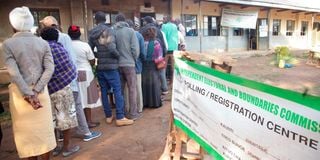2022 polls: Brutal voters sent home 76pc of MCAs

Voters queue to cast their ballots at Bulimbo Primary School in Matungu, Kakamega County.
What you need to know:
- Re-election rates per county also varied, with Nyandarua having the highest at 56 percent
- In the General Election, only 354 of the 1,450 elected MCAs retained their seats.
As county assemblies prepare to begin work following the swearing in of members of county assemblies (MCAs) this week, 991 out of the total 1,450 MCAs are new to the job, an indication of a critical electorate willing to make a statement at the ballot.
Save for the five wards of Utawala in Nairobi, South Gem in Siaya, Ololmasani in Narok, Thaana in Kitui and Mumias North in Kakamega that did not elect an MCA due to the death of candidates, a majority of the incumbents were sent packing while others vied for other positions.
In the General Election, only 354 of the 1,450 elected MCAs retained their seats according to totals from gazette notices from the Independent Electoral and Boundaries Commission (IEBC). This means that only 24 percent of MCAs returned to the legislature, a lower re-election rate compared to the other elective positions where governors had a 43 percent re-election rate, 47 percent for senators and 61 per cent for MPs — of all elective seats.
Re-election rates per county also varied, with Nyandarua having the highest at 56 percent. Of its 25 MCAs, 14 returned to the county assembly. But it was a different scenario in Wajir as all MCAs in the county will not be returning to the county assembly. All 30 legislators are new, an indication that voters were not happy with their performance. In 2017, only two of the 30 managed to be re-elected.
But as election candidates were gazetted, it was clear that this would be a tough fight, with each MCA seat attracting a numerous number of candidates. In Meru County for example, Muthara ward in Tigania East attracted a total of 27 candidates.
As more young people show their interest in politics, a number of them send the elderly home.
Mr Peter Kilonzo, a final year student at Mount Kenya University, defeated Joseph Wambua for the Mbiuni Ward seat in Machakos while 21-year-old casual labourer Timothy Mutwiri defeated 20 others including the incumbent to win the Kiegoi/Antubochiu ward MCA seat in Igembe South constituency, Meru County.
Despite many failing to retain their seats, 100 managed to make a comeback after five years in the political cold. They were ousted in the 2017 General Election.
In 58 constituencies, all MCAs are completely new, meaning the incumbents were sent packing by voters while others vied for other positions. This is a drop from 2017 as 94 constituencies at the time had all new MCAs. The 2017 election saw an even higher number sent home as 1,106 MCAs were completely new, meaning only 344 managed to be re-elected.
An analysis of regions shows how the voters punished politicians who sought to defend their seats on tickets considered unpopular in their areas as the influence of the presidential candidates and the “six-piece” voting pattern swept most out of power.
In the Mt Kenya region, out of the 250 MCAs spread out across the eight counties of Embu, Meru, Murang’a, Nyandarua, Kiambu, Tharaka Nithi, Nyeri, and Kirinyaga, 164 – or 66 per cent – are new. Another 20 managed to make a comeback after losing in the 2017 polls.
At the Coast, the six counties of Mombasa, Kilifi, Kwale, Tana River, Taita Taveta and Lamu have 91 new faces — which represents 70 per cent. Of the 130 MCAs from the region, only 35 were re-elected while four bounced back from 2017.
In Northern Kenya, there was a bloodbath as only 17 percent of the legislators were re-elected. Of the 120 MCAs in Garissa, Wajir, Marsabit, Mandera and Isiolo, 100 are new. Only 14 were re-elected and six are returning to the county assembly after losing in the 2017 General Election.
In the Lower Eastern counties of Machakos, Kitui and Makueni, only 24 out of the 110 MCAs were re-elected, an increase from the eight re-elected in 2017. Seventy-three legislators are completely new on the job while 12 are returning after five years in the political cold.
In the expansive former Rift Valley province comprising 15 counties, 290 of the total 410 MCAs are new. Only 91 were re-elected while 28 made a comeback to the assemblies, with Elgeyo Marakwet having the lowest re-election rate. Only two MCAs were re-elected in the county out of a total of 20. In Nakuru, 10 managed to defend their seats, which is a steep decline from the 46 out of the total 55 who managed to be re-elected in 2017.
The Western region comprising Busia, Kakamega, Bungoma and Vihiga has only 57 re-elected legislators out of the total 165. In Busia, only five of the 35 MCAs were re-elected while Kakamega saw 18 out of the 60 re-elected. Sixty-five percent or 107 legislators in the region are completely new.
The neighbouring Nyanza region – comprising Kisumu, Siaya, Homa Bay, Migori, Kisii and Nyamira counties – has 140 new MCAs out of the total 210. Fifty-four legislators were re-elected while 15 returned after losing in the 2017 elections.
But even as the MCA seat looks like one of the most difficult seats to retain, some have managed to occupy the seat since 2013. Out of the 1,450 seats, 79 have managed to retain their seats for the tenth consecutive year.





